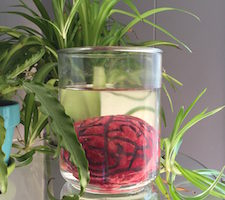Each and every day after school, I unload my kids’ backpacks. I check to see what food drive, conference or school trip we have forgotten, empty out the crumbs, notice if we’re missing yet another mitten or scarf, and finally, happily review the latest work brought home from school.
With one child in second grade and another in kindergarten, the artistic endeavors can consist of crayon colorings of George Washington’s face, a fantastical rendering of a fantasy world complete with a dragon, the lion from Narnia, and Helen Keller, or a series of small papers with my child’s name traced out over and over in an activity that I can only imagine ends up with the child turning into Jack Nicholson from The Shining.
“All tracing and no play makes Jack a dull boy…”
After examining each new display of proof that my child is, in fact, in school and has not been secreted away to one of the district’s work camps, I leave them out for my wife to enjoy. Then the kids take their treasures and file them, or place them in a magic box, or otherwise cause them to disappear from view.
Out of sight, out of mind.
The problem comes when we accidentally discover the hidden hoard. Suddenly, we are faced with a year’s worth of… of… art.
There is, of course, a next step in the life of this art, and that is a very special box in a very special place up in the very special attic. This very special box contains an accumulation of the jewels of our children’s childhood. But space is limited. Not everything graduates to the very special box, only the best of the best. Everything else magically finds its way – when no one is looking – to the very special garbage or recycling bin outside.
The challenge is in choosing what stays and what goes. Do we need to keep the early colorings where the outlines were more of a suggestion than a guideline? How many portraits of Harry Potter make the cut? And what about all the math homework? Why are we saving math homework? It’s almost as bad as agonizing over what to do with all the home-made birthday, Valentine’s Day and Mother’s and Father’s Day cards. In the moment, it is a precious sign of our child’s love, something that we treasure and hold dear to our hearts. A couple of months later, it is another folded piece of paper atop the bureau that reads “Happy Valentime’s Day!” in a psychotic red scrawl.
Counting pre-school, we’ve already got six complete years of work stored away. Six years of our children growing, learning, drawing, playing, drawing some more, learning to read, and more drawing. Especially pre-school. Sometimes my daughter would bring home so many pieces of artwork at the end of the day, I wondered if the teachers just shut the children in a padded room with paper and crayons and let them fend for themselves until just before the parents arrived to pick the kids up.
The anti-clutter machine within me (and there really is one in there, somewhere, despite what my wife may think) wants to throw caution to the wind, break out a half-way decent Merlot one evening after the kids are tucked away, open up a big, black Hefty bag and start chucking. I mean, who are we saving this stuff for, our kids or ourselves? When was the last time you ventured into your parents’ attic to reread the story you wrote in the third-grade about the dolphin with two fins?
On the other hand, there’s a part of me that believes we should err on the side of preservation and save as much as possible. Because, well, it was a good dolphin story, and I won a prize for it.
How am I expected to choose? What if my child grows up to be a world-famous artist whose works are worth millions? In that case, I’d be throwing out my retirement savings were I to jettison those works made while I still owned the rights to my prodigy’s talent.
A neighbor of mine brought an excellent idea to my attention. On that day in late spring when a parent’s mind turns to the growing pile of scholastic mementos in the closet, he or she should hook up with another parent. Then each parent goes through the other parent’s stash, deciding what’s worth keeping and what is mere clutter. Sounds good to me. Cut out the emotion, pare it down to the basics. “This is good. This is crap.” Then, just to ensure there are no second thoughts that involve dumpster diving, you hold a massive neighborhood bonfire.
In many ways, divesting ourselves of what we deem to be the lesser-accomplished work feels like passing judgment on our children. As if we’re saying, “On this day, you were good, but on this day, you didn’t do well.” It’s silly, I know. Each time my child sat down to draw something, he or she created something that was totally theirs, and totally unique. OK, maybe I don’t need every page of addition my child works on, but I can imagine a day, many years from now, after they’ve gone off to Harvard, when I sit up in the attic and open up the very special boxes. (I imagine there will be more than one by then.)
When you think about it, we’re not just hoarding our children’s artwork, we’re hoarding our children. These seemingly haphazard treasures will eventually be a gateway into the past, reminding us of a time when our children were young, innocent, and would still return our phone calls.
Ironically, in a very Elton-John-Circle-Of-Life way, what was once a very special box for my children will have become a very special box for their parents. And as I thumb through the artwork, remembering the look on their faces when they first showed me their drawing of Zeus striking down bad guys with a lightning bolt, I’ll be glad I saved more than I intended. ©







